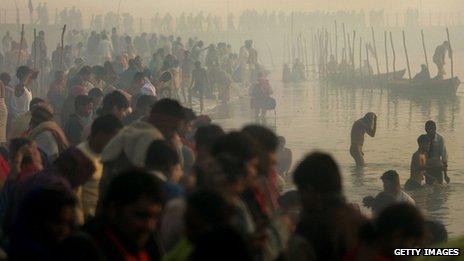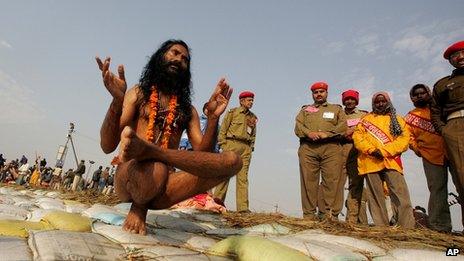Kumbh Mela festival
- Published

The Kumbh Mela is expected to be the biggest religious gathering of humanity in the world
India is a land of spectacles, it is a land of teeming millions and a land of an ancient culture and civilisation.
In my long years in India I have seen many spectacles but none so remarkable as the two Maha or Great Kumbh Melas which I attended.
I have seen vast crowds assemble but none as big as the millions who flocked to the north Indian city of Allahabad to bathe at the confluence where the cloudy waters of the river Ganges meet the blue waters of the river Yamuna on the most auspicious day of those Melas.
I have never been more forcefully reminded that India's age old culture survives today than I have been by those two Kumbh Melas.
Anyone who wants to enjoy the Kumbh Mela to the full must appreciate its many different aspects.
It is of course a great religious festival, the world's largest we are told, but there is much more to it than just the great bathing day, spectacular though that is.
Most spectacular of all are the naked sadhus or holy men, who career through the crowds dancing to the frenzied beat of drums and leaping in the air as they charge in to the river to bathe.
Then there are the sadhus to be seen on any day performing amazing acts of asceticism.
One sadhu I saw had held his arm up so long that it was withered and his nails curved round like talons, another was standing on one leg, and a third lying on a bed of thorns.
At Kumbh Melas there is much religious teaching also, and a multitude of discourses.

'There are the sadhus to be seen on any day performing amazing acts of asceticism'
They demonstrate the wide variety of Hindu traditions, and Hinduism's tolerance too. Some of the discourses seemed to me obscurantist, some profound, and some surprising.
The devotees of the 15th Century saint Kabir told me they condemned images of the deities and maintained that washing under a tap was just as good as bathing in the Ganges. No-one seemed to object to their unorthodox views. Perhaps that's because Hinduism is so varied that for most Hindus there is no concept of heresy.
Hindu pluralism is also shown by the different creation myths the Mela commemorates.
The word Kumbh means an urn, and one of the several myths is the story of an urn filled with the nectar of immortality which emerged from the primeval waters when they were being churned by gods and demons.
The urn was snatched by demons but the son of the ruler of heaven, the god Indira, recovered it. Drops from the urn fell at the Sangam and other places in India where Kumbh Melas are held.
Festival business
In India, politics enter into all walks of life and the Kumbh Mela is no exception.
In 1989, the campaign the Hindu nationalist Bharatiya Janata Party (BJP) hoped would bring it to power on a wave of Hindu nationalism was in full swing.

The festival is a feat of organisation by the authorities and pilgrims
In one of the tented pavilions I heard fanatic speakers fulminating against the mosque in Ayodhya they claimed stood on the birth place of the god Rama, and demanding that it be pulled down to be replaced with a temple.
Mela means a fair, and as with all fairs plenty of business is done at Kumbh Melas.
There are stalls selling everything a pilgrim might need including of course the accoutrements required for pujas, or worship. Barbers shaving heads do a roaring trade. The traditional priests who keep family records set up their stalls and do good business updating genealogies and performing ceremonies for the souls of the dead.
Both Kumbh Melas I saw were remarkable feats of organisation, occasions when the much-maligned Indian civil servants covered themselves with glory.
They constructed a vast tented city, laying down miles of steel plates for roads and constructing pontoon bridges. The administration also insured there was food for the pilgrims, and water too - sanitation, as well as electricity.
The police, not usually renowned for their gentleness, were politeness personified as they shepherded millions of pilgrims down to the river banks, keeping them in orderly queues, and insured their safety while bathing. But in this they were helped by Indians remarkable ability to organise themselves in situations which in most other countries would degenerate into chaos.
On the main bathing day of the 1989 Kumbh Mela I walked back to the press camp along with the army of pilgrims returning from the river.
Describing that experience I wrote: "I had never been in such a peaceful crowd. There was no frenzy, just the calm certainty of faith; the knowledge that what had to be done had been done."
Faith is the key to the Kumbh Mela.
It is a wonderful spectacle, a great demonstration of the variety and vigour of Hinduism, an occasion to preach politics and conduct business, but there would be no Kumbh Mela were it not for the faith that draws millions of pilgrims to the Sangam in Allahabad.
- Published2 September 2012